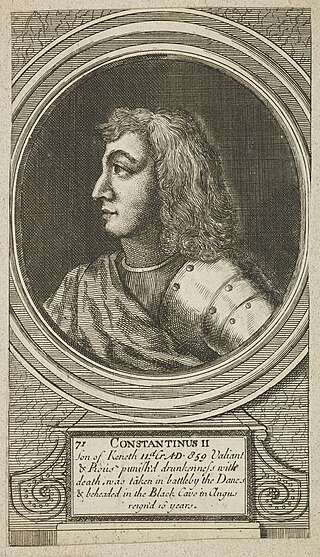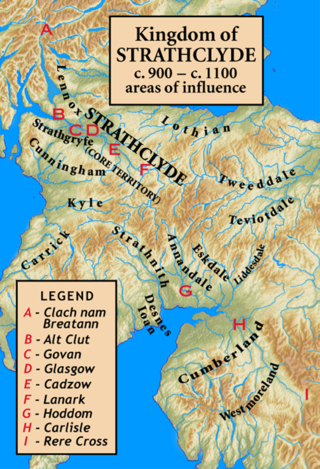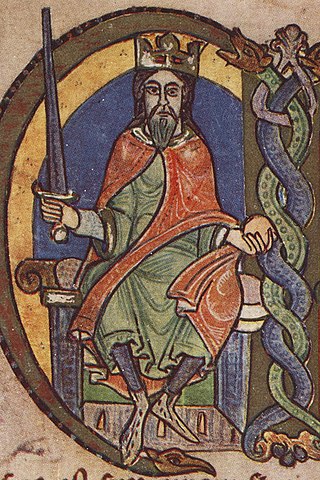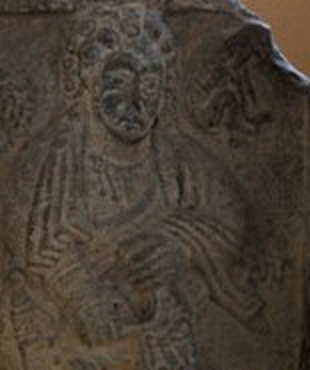
Causantín mac Cináeda was a king of the Picts. He is often known as Constantine I in reference to his place in modern lists of Scottish monarchs, but contemporary sources described Causantín only as a Pictish king. A son of Cináed mac Ailpín, he succeeded his uncle Domnall mac Ailpín as Pictish king following the latter's death on 13 April 862. It is likely that Causantín's reign witnessed increased activity by Vikings, based in Ireland, Northumbria and northern Britain. He died fighting one such invasion.
Kenneth MacAlpin or Kenneth I was King of Dál Riada (841–850), and King of the Picts (843–858) of likely Gaelic origin. He inherited the throne of Dál Riada from his father Alpín mac Echdach, founder of the Alpínid dynasty. Kenneth I conquered the kingdom of the Picts in 843–850 and began a campaign to seize all of Scotland and assimilate the Picts, for which he was posthumously nicknamed An Ferbasach. He fought the Britons of the Kingdom of Strathclyde and the invading Vikings from Scandinavia. Forteviot became the capital of his kingdom and Kenneth relocated relics, including the Stone of Scone from an abandoned abbey on Iona, to his new domain.

Strathclyde was a Brittonic kingdom in northern Britain during the Middle Ages. It comprised parts of what is now southern Scotland and North West England, a region the Welsh tribes referred to as Yr Hen Ogledd. At its greatest extent in the 10th century, it stretched from Loch Lomond to the River Eamont at Penrith. Strathclyde seems to have been annexed by the Goidelic-speaking Kingdom of Alba in the 11th century, becoming part of the emerging Kingdom of Scotland.

David I or Dauíd mac Maíl Choluim was a 12th-century ruler and saint who was Prince of the Cumbrians from 1113 to 1124 and later King of Scotland from 1124 to 1153. The youngest son of Malcolm III and Margaret of Wessex, David spent most of his childhood in Scotland, but was exiled to England temporarily in 1093. Perhaps after 1100, he became a dependent at the court of King Henry I of England, by whom he was influenced.
Alpín mac Echdach was a supposed king of Dál Riata, an ancient kingdom that included parts of Ireland and Scotland.
Óengus mac Fergusa was king of the Picts from 820 until 834. In Scottish historiography, he is associated with the veneration of Saint Andrew, the patron saint of Scotland, although this has not been proven.
Dúngal mac Selbaig was king of Dál Riata. His reign can best be placed in the years 723 to 726, beginning with the abdication of his father, Selbach mac Ferchair, who entered a monastery, and ending with the rise of Eochaid mac Echdach of the Cenél nGabráin. The High Medieval praise poem Duan Albanach names Dúngal the Impetuous, and claims that he ruled for seven years.
Fergus Mór mac Eirc was a possible king of Dál Riata. He was the son of Erc of Dalriada.
The House of Alpin, also known as the Alpínid dynasty, Clann Chináeda, and Clann Chinaeda meic Ailpín, was the kin-group which ruled in Pictland, possibly Dál Riata, and then the kingdom of Alba from the advent of Kenneth MacAlpin in the 840s until the death of Malcolm II in 1034.
Findláech mac Ruaidrí, son of Ruaidrí mac Donald, was the minor "king", locally called "Mormaer", of Moray, in the north of modern-day Scotland, from some point before 1014 until his death in 1020. Findláech's son Macbethad mac Findláech, was made famous as the protagonist of William Shakespeare's play Macbeth.
Máel Coluim mac Máil Brigti was King or Mormaer of Moray (1020–1029), and, as his name suggests, the son of a Máel Brigte. As with his predecessor Findláech mac Ruaidrí, sources call him "King of Scotland."
Uuen son of Onuist, commonly referred to by the hypocoristic Eóganán, was king of the Picts between AD 837–839.
Ciniod, Cináed or Cinadhon, son of Uuredech, was king of the Picts from 763 until 775.

The origins of the Kingdom of Alba pertain to the origins of the Kingdom of Alba, or the Gaelic Kingdom of Scotland, either as a mythological event or a historical process, during the Early Middle Ages.

The High Middle Ages of Scotland encompass Scotland in the era between the death of Domnall II in 900 AD and the death of King Alexander III in 1286, which was an indirect cause of the Wars of Scottish Independence.
Rí, or commonly ríg (genitive), is an ancient Gaelic word meaning 'king'. It is used in historical texts referring to the Irish and Scottish kings, and those of similar rank. While the Modern Irish word is exactly the same, in modern Scottish Gaelic it is rìgh, apparently derived from the genitive. Cognates include Gaulish Rix, Latin rex/regis, Spanish rey, French roi, Sanskrit raja, and German Reich.
Óengus mac Fergusa may refer to:

St Serf's Inch or St Serf's Island is an island in Loch Leven, in south-eastern Perth and Kinross, Scotland. It was the home of a Culdee and then an Augustinian monastic community, St Serf's Inch Priory.

Political and military events in Scotland during the reign of David I are the events which took place in Scotland during David I of Scotland's reign as King of Scots, from 1124 to 1153. When his brother Alexander I of Scotland died in 1124, David chose, with the backing of Henry I of England, to take the Kingdom of Alba for himself. David was forced to engage in warfare against his rival and nephew, Máel Coluim mac Alaxandair. Subduing the latter took David ten years, and involved the destruction of Óengus, mormaer of Moray. David's victory allowed him to expand his control over more distant regions theoretically part of the Kingdom. In this he was largely successful, although he failed to bring the Earldom of Orkney into his kingdom.

The House of Óengus is a proposed dynasty that may have ruled as Kings of the Picts and possibly of all of northern Great Britain, for approximately a century from the 730s to the 830s AD. Their first ruler of Pictland was the great Óengus I of the Picts, who may be the figure carved into the St Andrews Sarcophagus pictured on the right.








